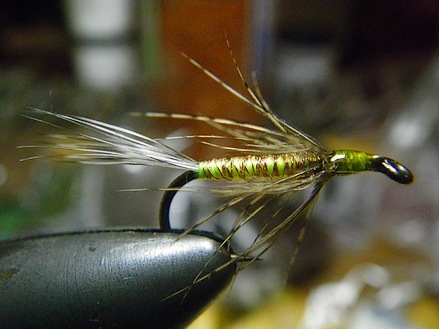As much as we’d like it to warn us, great flies have no aura about them when removed from the vise, no halo to clue its creator to cease embellishment, as his creation will be the bane of local gamefish for the next couple of decades.
We’ve taken it for granted we can spot fishy potential and great colors, most of us have fly boxes bulging with imitation bug parts, gooey soft textures, and colors dripping with authenticity.
The fact we carry so many is clue that we really can’t tell what a fish thinks, likes, or eats.
To remind me that I know nothing of fish vision, let alone what stimulates taste, I would add special flies to my driver’s side sun visor. Flies that caught 20” fish and those whose consistent greatness had earned them a place in what would become a testimonial to what large wary fish preferred …
… and why gooey textures, feelers, and bug parts didn’t appear in any of the really successful flies, most of which didn’t even look buggy to my eye.

Chartreuse floss body overwrapped with fine copper wire, no particular pattern – just lay on forty turns until about half the chartreuse has been covered. Two turns of dark partridge hackle and a grizzly tail completes this unknown work.
… no eyeballs, no individual legs, and a primary color that you’d be hard pressed to find in Mother Nature…
No name that I can remember, given to me by a client that swore by it, and after my lip curled uncontrollably, I let him try it just so he’d stop fidgeting with his flies and start fishing all my better ideas.
… fortunately we didn’t need any of my flies.
Tied in sizes from #10 – #14, he mentioned how he’d assumed the fish ate it as a green caddis.
As I’ve recently unearthed the box of flies I removed from that visor, I figured to share some of the nameless patterns you’ll never see in any fly shop, just to give those that are struggling with invention a glimpse of pure death – and how little refinement and entomology is really needed.

I carry a cab full of flies for saltwater! And yet, I return to one or two that paid off for a species. Is it knowledge, stubbornness, or genius? I doubt the last for me.
In fresh, it depends on the stream. After reading and sampling the water, I almost always choose a soft hackle with tiny nymph dropper or a Klink/Stimi with a dropper. Add force of habit to the above three choices.
Like the client that you mention above, I am always full of wonder at the prospect of catching fish!
You got that right, Keith.
No really great trout fly has more than five ingredients- and that’s counting the thread.
One the very best, Sawer’s Pheasant Tail Nymph, has only TWO; fine copper wire and pheasant tail fibers.
Everyone still crowds around the fellow tying the good looking flies, despite the knowledge it’s those he’s not tying that catch all the fish.
He’ll never be famous tying flies that catch fish – it’s tying flies that catch fishermen that command the real dollars …
a couple things have changed my tying in the last season or so.
1) a video showing bugs underwater in a stream.
no real color but LEGS.
2) a british psychologist delving into the
behavior of starving people and the lack
of rationality or judgement they display.
3) biologists have determined that some fish
can count to three.
my take on this: hungry fish will eat ANYTHING with at least three legs.
the sad truth is that after tying hundreds of patterns i’ve gone back to couple of very old school, very basic patterns and caught more fish from august to december of 2010 than i had in 2008 and 2009 combined.
I like this one. Tied half-a-dozen (with slightly the wrong materials: Can’t seem to find that superfine copper thread) to try on the German small streams this spring.
The superfine copper wire is usually found in small electrical motors, five or six different colors, often wound on plastic armatures and sealed (so you don’t recognize it as wire).
I think in electric terms it’s 36-38 AWG, sometimes you can get it in half pound spools on the Internet. The last 1/2 pounder I purchased was $8. One will last a lifetime.
Should have remembered that. Been out of electrical engineering and in IT for too long..
1500 meters, a “metric mile”, just over 5 Euro’s….. That’ll do…